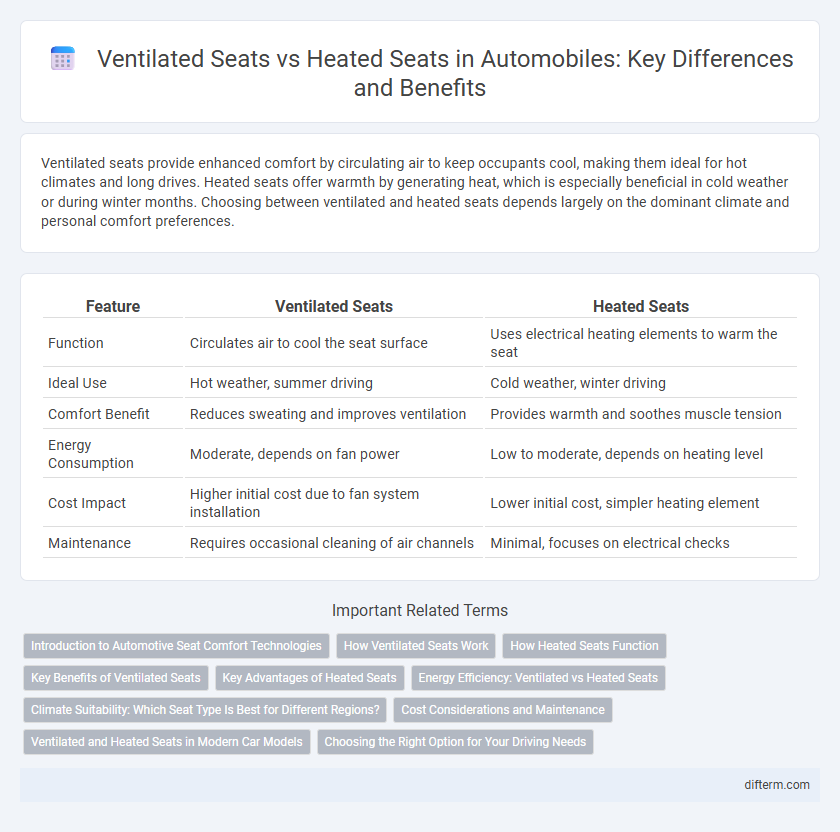Ventilated seats provide enhanced comfort by circulating air to keep occupants cool, making them ideal for hot climates and long drives. Heated seats offer warmth by generating heat, which is especially beneficial in cold weather or during winter months. Choosing between ventilated and heated seats depends largely on the dominant climate and personal comfort preferences.
Table of Comparison
| Feature | Ventilated Seats | Heated Seats |
|---|---|---|
| Function | Circulates air to cool the seat surface | Uses electrical heating elements to warm the seat |
| Ideal Use | Hot weather, summer driving | Cold weather, winter driving |
| Comfort Benefit | Reduces sweating and improves ventilation | Provides warmth and soothes muscle tension |
| Energy Consumption | Moderate, depends on fan power | Low to moderate, depends on heating level |
| Cost Impact | Higher initial cost due to fan system installation | Lower initial cost, simpler heating element |
| Maintenance | Requires occasional cleaning of air channels | Minimal, focuses on electrical checks |
Introduction to Automotive Seat Comfort Technologies
Ventilated seats use integrated fans and perforated leather or fabric to circulate air, providing cooling and moisture-wicking benefits for enhanced comfort in hot climates. Heated seats employ electric heating elements embedded in the seat cushion and backrest to deliver warmth, improving comfort during cold weather and aiding muscle relaxation. Both technologies leverage advanced materials and electronic controls to optimize the driving experience by maintaining occupant thermal comfort.
How Ventilated Seats Work
Ventilated seats use built-in fans and perforated leather or fabric to circulate air, enhancing comfort by reducing heat and moisture buildup during warm weather. This cooling mechanism operates by drawing air through small holes in the seat surface, effectively dissipating body heat and improving ventilation. Unlike heated seats that generate warmth, ventilated seats maintain a cooler seating environment, especially beneficial in hot climates or long drives.
How Heated Seats Function
Heated seats function by using electric heating elements embedded within the seat cushions, which generate warmth to increase passenger comfort during cold weather. These elements are connected to the vehicle's electrical system and controlled via switches or climate control interfaces, allowing precise temperature adjustments. The heat radiates through the seat material, providing direct warmth to the occupant and enhancing overall driving comfort in chilly conditions.
Key Benefits of Ventilated Seats
Ventilated seats provide superior comfort by actively circulating air through perforated cushions, reducing heat buildup and moisture, which prevents sweating during hot weather. This airflow technology enhances driver and passenger relaxation on long trips by maintaining an optimal body temperature. Unlike heated seats that only provide warmth, ventilated seats improve overall cabin comfort by offering cooling benefits, contributing to a more pleasant driving experience.
Key Advantages of Heated Seats
Heated seats provide rapid warmth during cold weather, enhancing driver and passenger comfort by targeting key body areas such as the lower back and thighs. They improve circulation and reduce muscle stiffness on long journeys, contributing to overall driver alertness and well-being. Unlike ventilated seats, heated seats maintain warmth even in freezing temperatures, making them essential for cold climates and winter driving conditions.
Energy Efficiency: Ventilated vs Heated Seats
Ventilated seats use fans to circulate air, consuming less energy compared to heated seats that rely on electrical heating elements generating heat through resistance. The energy consumption of ventilated seats averages around 20-50 watts, whereas heated seats can draw between 50-150 watts, impacting the vehicle's overall energy efficiency and battery range, especially in electric vehicles. Optimizing seat temperature control with ventilated systems can reduce power load, contributing to improved fuel economy and extended electric driving range.
Climate Suitability: Which Seat Type Is Best for Different Regions?
Ventilated seats excel in hot and humid climates by promoting airflow and reducing sweat, making them ideal for regions with high temperatures like the southern United States or the Middle East. Heated seats provide targeted warmth, enhancing comfort in colder areas such as Northern Europe or Canada by quickly alleviating chill during winter months. Choosing between ventilated and heated seats depends largely on the regional climate, with many manufacturers offering dual-function options to cater to diverse environmental needs.
Cost Considerations and Maintenance
Ventilated seats typically incur higher initial costs due to complex cooling fans and electrical components, while heated seats are generally more affordable with simpler resistive heating elements. Maintenance for ventilated seats can be more expensive and frequent, as fans may accumulate dust and require repair or replacement, whereas heated seats often need less upkeep with fewer parts prone to failure. Choosing between the two involves weighing upfront investment against long-term maintenance expenses and vehicle usage patterns.
Ventilated and Heated Seats in Modern Car Models
Ventilated seats in modern car models use built-in fans to circulate air through perforated seat surfaces, enhancing comfort by reducing heat and moisture buildup during warm weather. Heated seats employ embedded heating elements that provide warmth, improving comfort in cold climates by quickly raising seat temperature. Both features integrate with vehicle climate control systems to deliver optimized, personalized comfort based on environmental conditions and driver preferences.
Choosing the Right Option for Your Driving Needs
Ventilated seats enhance driving comfort by circulating air to cool the body during hot weather, making them ideal for warm climates or long summer drives. Heated seats provide targeted warmth by warming the seat surface, offering relief in cold conditions or during winter months. Selecting between ventilated and heated seats depends on your typical climate conditions and personal comfort preferences to optimize your driving experience.
ventilated seats vs heated seats Infographic

 difterm.com
difterm.com